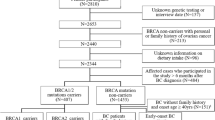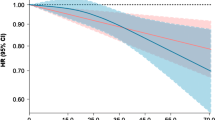Abstract
Although epidemiologic studies have shown an inverse association between isoflavones and breast cancer risk, little evidence for a dose–response relation is available. We conducted hospital-based case–control studies of patients aged 20–74 years with primary, incident, histologically confirmed invasive breast cancer, and matched controls from medical checkup examinees in Nagano, Japan and from cancer-free patients in São Paulo, Brazil. A total of 850 pairs (390 Japanese, 81 Japanese Brazilians and 379 non-Japanese Brazilians) completed validated food frequency questionnaires. The odds ratio of breast cancer according to isoflavone intake was estimated using a conditional logistic regression model. We found a statistically significant inverse association between isoflavone intake and the risk of breast cancer for Japanese Brazilians and non-Japanese Brazilians. For Japanese, a non-significant inverse association was limited to postmenopausal women. In the three populations combined, breast cancer risk linearly decreased from ‘no’ to ‘moderate’ isoflavone intake and thereafter leveled off. Compared to non-consumers, adjusted odds ratios (95% confidence interval) for consumers in increasing quintile intake categories (median intake in each category: 8.7, 23.1, 33.8, 45.7, and 71.3 mg/day) were 0.69 (0.44–1.09), 0.54 (0.31–0.94), 0.45 (0.26–0.77), 0.34 (0.19–0.62), and 0.43 (0.24–0.76), respectively. Overall, we found an inverse association between dietary isoflavone intake and risk of breast cancer. Our finding suggests a risk-reducing rather than risk-enhancing effect of isoflavones on breast cancer within the range achievable from dietary intake alone. In addition, women may benefit from risk reduction if they consume at least moderate amounts of isoflavones.

Similar content being viewed by others
Abbreviations
- CI:
-
Confidence interval
- ER:
-
Estrogen receptor
- FFQ:
-
Food-frequency questionnaire
- OR:
-
Odds ratio
- PR:
-
Progesterone receptor
References
Adlercreutz H (1998) Epidemiology of phytoestrogens. Baillieres Clin Endocrinol Metab 12:605–623. doi:10.1016/S0950-351X(98)80007-4
Magee PJ, Rowland IR (2004) Phyto-oestrogens, their mechanism of action: current evidence for a role in breast and prostate cancer. Br J Nutr 91:513–531. doi:10.1079/BJN20031075
Limer JL, Speirs V (2004) Phyto-oestrogens and breast cancer chemoprevention. Breast Cancer Res 6:119–127. doi:10.1186/bcr781
Yamamoto S, Sobue T, Kobayashi M et al (2003) Soy, isoflavones, and breast cancer risk in Japan. J Natl Cancer Inst 95:906–913
Hirose K, Imaeda N, Tokudome Y et al (2005) Soybean products and reduction of breast cancer risk: a case–control study in Japan. Br J Cancer 93:15–22. doi:10.1038/sj.bjc.6602659
Santos Silva I, Mangtani P, McCormack V et al (2004) Phyto-oestrogen intake and breast cancer risk in South Asian women in England: findings from a population-based case–control study. Cancer Causes Control 15:805–818. doi:10.1023/B:CACO.0000043431.85706.d8
Linseisen J, Piller R, Hermann S et al (2004) Dietary phytoestrogen intake and premenopausal breast cancer risk in a German case–control study. Int J Cancer 110:284–290. doi:10.1002/ijc.20119
Wu AH, Wan P, Hankin J et al (2002) Adolescent and adult soy intake and risk of breast cancer in Asian-Americans. Carcinogenesis 23:1491–1496. doi:10.1093/carcin/23.9.1491
Verheus M, van Gils CH, Keinan-Boker L et al (2007) Plasma phytoestrogens and subsequent breast cancer risk. J Clin Oncol 25:648–655. doi:10.1200/JCO.2006.06.0244
Iwasaki M, Inoue M, Otani T et al (2008) Plasma isoflavone level and subsequent risk of breast cancer among Japanese women: a nested case–control study from the Japan public health center-based prospective study group. J Clin Oncol 26:1677–1683. doi:10.1200/JCO.2007.13.9964
Trock BJ, Hilakivi Clarke L, Clarke R (2006) Meta-analysis of soy intake and breast cancer risk. J Natl Cancer Inst 98:459–471
Wu AH, Yu MC, Tseng CC et al (2008) Epidemiology of soy exposures and breast cancer risk. Br J Cancer 98:9–14. doi:10.1038/sj.bjc.6604145
Day JK, Besch Williford C, McMann TR et al (2001) Dietary genistein increased DMBA-induced mammary adenocarcinoma in wild-type, but not ER alpha KO, mice. Nutr Cancer 39:226–232. doi:10.1207/S15327914nc392_11
Ju YH, Allred KF, Allred CD et al (2006) Genistein stimulates growth of human breast cancer cells in a novel, postmenopausal animal model, with low plasma estradiol concentrations. Carcinogenesis 27:1292–1299. doi:10.1093/carcin/bgi370
Messina M, Nagata C, Wu AH (2006) Estimated Asian adult soy protein and isoflavone intakes. Nutr Cancer 55:1–12. doi:10.1207/s15327914nc5501_1
Horn Ross PL, Hoggatt KJ, West DW et al (2002) Recent diet and breast cancer risk: the California Teachers Study (USA). Cancer Cause Control 13:407–415. doi:10.1023/A:1015786030864
Horn Ross PL, John EM, Lee M et al (2001) Phytoestrogen consumption and breast cancer risk in a multiethnic population: the Bay Area Breast Cancer Study. Am J Epidemiol 154:434–441. doi:10.1093/aje/154.5.434
Fink BN, Steck SE, Wolff MS et al (2007) Dietary flavonoid intake and breast cancer risk among women on Long Island. Am J Epidemiol 165:514–523. doi:10.1093/aje/kwk033
Touillaud MS, Thiebaut AC, Niravong M et al (2006) No association between dietary phytoestrogens and risk of premenopausal breast cancer in a French cohort study. Cancer Epidemiol Biomarkers Prev 15:2574–2576. doi:10.1158/1055-9965.EPI-06-0543
Keinan Boker L, Van Der Schouw YT, Grobbee DE et al (2004) Dietary phytoestrogens and breast cancer risk. Am J Clin Nutr 79:282–288
Ferlay J, Bray F, Pisani P et al (2004) GLOBOCAN 2002 Cancer Incidence, Mortality and Prevalence Worldwide, IARC CancerBase No. 5, version 2.0. IARCPress, Lyon
Iwasaki M, Mameri CP, Hamada GS et al (2008) Secular trends in cancer mortality among Japanese Immigrants in the State of São Paulo, Brazil, 1979–2001. Eur J Cancer Prev 17:1–8
Tsubono Y, Takamori S, Kobayashi M et al (1996) A data-based approach for designing a semiquantitative food frequency questionnaire for a population-based prospective study in Japan. J Epidemiol 6:45–53
Yamamoto S, Sobue T, Sasaki S et al (2001) Validity and reproducibility of a self-administered food-frequency questionnaire to assess isoflavone intake in a Japanese population in comparison with dietary records and blood and urine isoflavones. J Nutr 131:2741–2747
Kimira M, Arai Y, Shimoi K et al (1998) Japanese intake of flavonoids and isoflavonoids from foods. J Epidemiol 8:168–175
Arai Y, Watanabe S, Kimira M et al (2000) Dietary intakes of flavonols, flavones and isoflavones by Japanese women and the inverse correlation between quercetin intake and plasma LDL cholesterol concentration. J Nutr 130:2243–2250
The Council for Science, Technology Ministry of Education C, Sports, Science, Technology, Japan (2005) Standard Tables of Food Composition in Japan, the fifth revised and enlarged edition. National Printing Bureau, Tokyo
U.S. Department of Agriculture, Agricultural Research Service, USDA Nutrient Data Laboratory (2006) USDA National Nutrient Database for Standard Reference Release 18
Kuiper GG, Lemmen JG, Carlsson B et al (1998) Interaction of estrogenic chemicals and phytoestrogens with estrogen receptor beta. Endocrinology 139:4252–4263. doi:10.1210/en.139.10.4252
Acknowledgments
This study was supported by a Grant-in-Aid for Research on Risk of Chemical Substances from the Ministry of Health, Labour and Welfare of Japan, and Grants-in-Aid for Scientific Research on Priority Areas (17015049) and for Young Scientists (B) (17790378 and 19790415) from the Ministry of Education, Culture, Sports, Science, and Technology of Japan and the Japan Society for the Promotion of Science. We are grateful to the participants in the “São Paulo-Japan Breast Cancer Study Group”: C. I. Yamaguchi, C. M. Kunieda, and S. S. Sugama (Nikkei Disease Prevention Center, São Paulo); C. K. Taniguchi and J. A. Marques (Departamento de Ginecologia, Hospital Pérola Byington, São Paulo); M. R. Eichhorn (Departamento de Nutrição, Hospital Pérola Byington, São Paulo); H. Iyeyasu, M. S. Maciel, S. M. T. Carvalho, J. B. D. Collins, and C. E. M. Fontes (Departamento de Mastologia, Hospital A.C. Camargo, São Paulo); L. P. Kowalski and J. M. F. Toyota (Departamento de Cirurgia de Cabeça e Pescoço e Otorrinolaringologia, A. C. Camargo Hospital, São Paulo); E. M. Barbosa (Departamento de Mastologia, Instituto Brasileiro de Controle ao Câncer, São Paulo); O. Ferraro (Departamento de Mastologia, Hospital do Servidor Público Estadual Francisco Morato de Oliveira, São Paulo); R. Anzai (Departamento de Mastologia, Hospital Santa Cruz); E. H. Hotta and D. A. Petti (Instituto de Ginecologia e Mastologia, Hospital Beneficencia Portuguesa); S. Mendes (Instituto Brasileiro de Mastologia e Ginecologia, Hospital Beneficencia Portuguesa).
Author information
Authors and Affiliations
Corresponding author
Rights and permissions
About this article
Cite this article
Iwasaki, M., Hamada, G.S., Nishimoto, I.N. et al. Dietary isoflavone intake and breast cancer risk in case–control studies in Japanese, Japanese Brazilians, and non-Japanese Brazilians. Breast Cancer Res Treat 116, 401–411 (2009). https://doi.org/10.1007/s10549-008-0168-1
Received:
Accepted:
Published:
Issue Date:
DOI: https://doi.org/10.1007/s10549-008-0168-1




